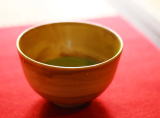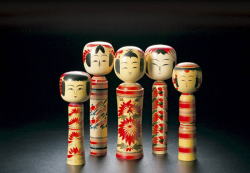
photo by Tohoku Bureau of Economy, Trade and Industry |
MIYAGI TRADITIONAL KOKESHI |
| (Miyagi)/doll |
| MIYAGI TRADITIONAL KOKESHI was born in 200years ago. Hairstyle is a unique.
Thick body which was drawn graphic floral pattern. The neck is turning
with sound"Kii-Kii". There are Naruco, Yajirou, Tookarida and
Sendai Kokeshi. |
| |
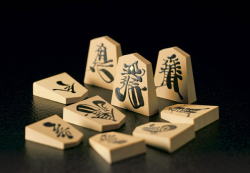
photo by Tohoku Bureau of Economy, Trade and Industry |
TENDOU SYOUGI KOMA |
| (Yamagata)/syougi piece |
| Tendou Syougi pieces share of market more than 95% of the national production
of pieces. Its origin is the time of Edo Period. The pieces of the procedure
by craftsmen has received the designation of traditional crafts of the
country in 1996. |
| |
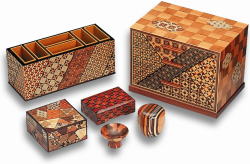
photo by Kanagawa Prefectural Government |
HAKONE YOSEGIZAIKU |
| (Kanagawa)/box, small drawer, jewelry box, secret box |
| This technique was beginning in Hatajuku Hakone-machi in the end of Edo
Period. Odawara, hakone region has become only production locality in Japan.
It creates a sophisticated geometric pattern. It was designated as a Traditional
Craft by Japanese Government in 1984. |
| |
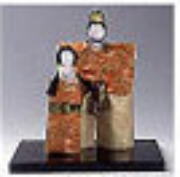
photo by Kansai Bureau of Economy,Trade and Industry HP,Traditional Crafts
information page |
KYOU NINGYOU |
| (Kyoto)/doll |
| Doll was created as a talisman for chirdren. Kyoto has prospered as a center
of making doll. Kyou doll is making by master with all handiwork as head,
hair, limbs, props, dressing that has finely division of labor. There are
hina doll, gosyo doll, ichimatsu doll and others. It was designated as
a Traditional Craft by Japanese Government in 1986. |
| |
photo by Tottori Prefectural Government HP, Tottori Traditional Arts &
Crafts information TORINET
photo by Tottori Prefectural Government HP, Tottori Traditional Arts & Crafts information TORINET-Photos library |
NAGASHI BINA |
| (Tottori)/doll, good luck charm |
| The event "Nagashi bina" 3th.March of lunar calendar has been
done as old custum. People give disaster to doll, they sink doll into river.
It is characterized woman and man who are wearing red wear and Eboshi with
gold. It is loved widely as folk toy to represent the Tottori Prefectre.
It was designated Tottori specified technology craft. |
| |

photo by Tottori Prefectural Government HP, Tottori Traditional Arts & Crafts information TORINET |
DOREI |
| (Tottori)/doll, good luck charm |
| Dorei is the soil tin. History of it was so old, its date back to Jomon
Period. Dorei have the power of the talisman against evil, it seems to
have been used for the festival. In the current, It produce handmade one
by one for festival, auspicious history and home. There are widely popular
to people of bell collector of DOREI. It helped to disseminate information
in the region. It was designated Tottori specified technology craft. |
| |
photo by Tottori Prefectural Government HP, Tottori Traditional Arts &
Crafts information TORINET
photo by Tottori Prefectural Government HP, Tottori Traditional Arts & Crafts information TORINET-Photos library |
KIRIN JISHI |
| (Tottori)/doll, good luck charm, wall hanging |
| Kirinjishi dancing is the traditional performing art of unique travellnaba
region in Tottori Eastern area. Its origin is Edo Period. Kirinjishi dancing
is danced in Festival, the New Year Festival, wedding etc. Kirinjishi is
made motief by Kirinjishi dancing. It was designated Tottori specified
technorogy. |
| |
photo by Yamaguchi Prefectural Government HP, Yamaguchi Brand Museum |
OOUCHI NURI(BINA) |
| (Yamaguchi)/doll, kitchen ware, tray |
| It has traditional for 600years. It tells now the pomp of Ouchi culture to boast of his wealth. It was characterized by elegant picture pattern with OOUCHIBINA. Its coating is characterized using the ground color paint with "Oouchi Shu" that is not tea or red. It was designated as a Traditional Craft by Japanese Government in 1989. |
| |

photo by Yamaguchi Prefectural Government HP, Yamaguchi Brand Museum |
ONI YOUZU |
| (Yamaguchi)/kite |
| Oni youzu is the bizarre aspect kite. It is made in Island of Mishima in
Yamaguchi Prefecture. Youzu is close-up of the face of the damon. Tail
of stripes of reds and white called Heko. It was said to be from Heian
Period. There is a custum to make a large kite with friends and relatives
gathered at the end of the year when eldest son was born with praying the
his growth. |
| |

photo by Yamaguchi Prefectural Government HP, Yamaguchi Brand Museum |
KOTO |
| (Yamaguchi)/Japanese harp |
| Koto is stringed instrument in its own was introduced from China. It used
in ancient court music from the Nara Period. It ad been a faborite among
the aristocracy. Even harp on the same figure, there is a personality each
and have delicate tone. |
| |

photo by Yamaguchi Prefectural Government HP, Yamaguchi Brand Museum |
FUKU CHOUCHIN |
| (Yamaguchi)/ lantern, doll |
| FUGU is fish on behalf of Shimonoseki city. FUKU TYOUCHIN is lanterns made
by FUGU. There are from the little ones about 15cm, up to a big more than
60cm. And lanterns of porcupine fish also made. |
| |
photo by Ehime Prefectural Government HP, Ehime good products picture book |
HIME DARUMA |
| (Ehime)/doll, luck goods |
| It was sold for a long time in Camellia Festival of the IZUYONOHIKONOMIKOTO
Shrine as a bringer of good luck and easy delivery prayer disease convalescenece.
It is said, growing up in good health when children play and be able to
start up faster from disease when sick decorate. Recently new character
was born "AICHAN". |
| |
photo by Ehime Prefectural Government HP, Ehime good products picture book |
SEKKU KOINOBORI |
| (Ehime)/stremer |
| Carp of Uwajima is characterized stout and close to the shape of the actual carp with making unique texture by traditional techniques. Cutting, design, dyeing and sewing are by all hand. It finish for 10 days or 1week. Its length is from 1m 20cm to 11m. |
| |
photo by Ehime Prefectural Government HP, Ehime good products picture book |
UWAJIMA USHIONI HARIKO |
| (Ehime)/doll, luck goods |
| It is purchased as a lucky charm. USHIONI is pleasesed as inviting fortune
and paying devil. Its head is decorated the entrance as a against evil
in Nanyo region in Ehime Prefectre. There are Buyare(small USHIONI riding
a palm), couple USHIONI, Invite USHIONI and Born child USHIONI. It is all
in hand. |
| |

photo by Fukuoka Prefectural Government HP, Traditional Craft page |
HAKATA NINGYOU |
| (Fukuoka)/doll |
| It is said beginning that one of the tiler baked rustic soil doll as a
hobby fro about 400years ago. It is made in a novel idea not to be caught
in the tradition. It is exported to foreign countries not only in Japan.
Its main producing area is Fukuoka city. It was designated as a Traditional
Craft by Japanese Government in 1976. |
| |

photo by Nagasaki Prefectural Government HP, Nagasaki Traditional Craft
Page and Toukei kids |
 KOGA NINGYOU KOGA NINGYOU |
| (Nagasaki)/doll |
| It is counted as one of Japan's three major soil doll with Fushimi doll
in Kyoto Prefecture and Tsutsumi doll in Sendai Prefecture. It has been
handed down tells the creek home for generations that is Koga village from
in 1592. The feature is incorporated a bold primary colors of red, white,yellow
and black in the simplicity. It was designated as a Nagasaki specified
technology craft in 1993. |
| |

photo by Nagasaki Prefectural Government HP, Nagasaki Traditional Craft Page and Toukei kids |
 SASEBO KOMA SASEBO KOMA |
| (Nagasaki)/top |
| It is shallots type top natinally renowned in the rich colors and exotic
elegance. It is said that its shape was used of Taiwan or India. It was
brought over to Nagasaki Prefecture from China. It was designated as a
Nagasaki specified technology craft in 1993. |
| |

photo by Nagasaki Prefectural Government HP, Nagasaki Traditional Craft Page and Toukei kids |
 NAGASAKI HATA & BIDORO YOMA NAGASAKI HATA & BIDORO YOMA |
| (Nagasaki)/kite, yarn |
| Nagasaki Kite are more than 2000 species. It has a unique feature in pattern
and from. Bidro Mayo is with a power of glass to kite string. It is used
for battle of Kite and fighting with swords by each other kite string.
It was designated as a Nagasaki specified technology craft. |
| |

photo by Nagasaki Prefectural Government HP, Nagasaki Traditional Craft Page and Toukei kids |
 GOTOU BARAMON GOTOU BARAMON |
| (Nagasaki)/kite |
| It has been popular locally for a long time in Gotou region. It was decorated
when the baby's first annual festival of the boy, and be praying for success
in life and robust growth. String are just stretched bow of bamboo head,
so beat sound has its own lncreasing. It was designated as a Nagasaki specified
technology craft in 1993. |
| |

photo by Nagasaki Prefectural Government HP, Nagasaki Traditional Craft Page and Toukei kids |
 IKIONI DAKO IKIONI DAKO |
| (Nagasaki)/kite |
| It is made by motif as old legend of "YURIWAKA DAIJIN legend".
It is painted picture of fighting with warrior and demon. String are jus
stretched bow of bamboo head, so beat sound has its own increasing. It
was designated as a Nagasaki specified technology craft in 1993. |
| |

copyright: |
 TSUGARU DAKO TSUGARU DAKO |
| (Aomori)/kite, nebuta |
| TSUGARU DAKO is kite that was painting traditional chinese tales, such
as Suikoden and Sangokusi. Their paintings were created by the brave samurai
warriors and colorful illustrations. Their frames are created by Aomori
cypress wood which is cut into small strips. |
| |

copyright: |
 NANBU HIMEMARI NANBU HIMEMARI |
| (Aomori)/decorating ball |
| NANBU HIMEMARI is loved-products that has been popular from Heian Period.
They made from cotton, bracken and the husks of rice and buckwheat. Their
core was wrapped around by cotton. And then Coloured thread is woven around
to creat the base shade. Then other colores stech are created in a diamond
or triangular pattern. They are incomparably beautiful. |
| |

copyright: |
 NEBUTA HANETO NINGYOU NEBUTA HANETO NINGYOU |
| (Aomori)/doll |
| All of NEBUTA HANETO NINGYOU is were created by hand from their hat to
tiptoes, and in the image of Haneto. Haneto is preform dances at the Aomori
Nebuta Festival. |
| |

copyright: |
TOKARIDAKEI YUDA KOKESHI |
| (Iwate)/doll |
| It is so splendor and with slender body and big head. OYONE KOKESHI is
popular type of topknot on the head. |
| |

copyright: |
NANBUKEI KOKESHI |
| (Iwate)/doll |
| It made from Hanamaki city. It has white skin and head dizzy by neck movement
is fitted. It called KINAKINA and It is characteristic of the system only
in the country in southern area in Iwate. |
| |

copyright: |
HARIKO NO KINNO BEKOKKO |
| (Iwate)/doll |
| It was laminated handmade Japanese paper over and over again, as a toy
gold cow type of swing. Be loved as mascot of lucky and flourished business.
|
| |

copyright: |
CHAGU-CHAGU UMAKO |
| (Iwate)/doll |
| It is coloring in the wood carving technique, and further decorated with.
Its'method is unusual and few costumes in Japan. |
| |

copyright: |
 MATSUKASA FUURIN MATSUKASA FUURIN |
| (Miyagi)/wind chime, kettle of tea ceremony |
| Reveration tone and clear features. As wind chimes using(bullion mutual
agreement sand-l)from the sum is only iron in abroad and Japan.Techniques
while are protecting, the transmission of a secret from father to a son. |
| |

copyright: |
GOTEN MARI |
| (Yamagata)/decolating ball |
| It has 350years history and tradition. Decolating boll is elegant with
a beautiful combination of colors and patterns. Ms. Fumi Ueno reproduced
the work and techniques in 1960. Now her daughter who is Mari Ichikawa
are producing it. |
| |

copyright: |
 TOKYO SYAMISEN TOKYO SYAMISEN |
| (Tokyo)/syamisen |
| Long ago, it was called three chord(SANGEN). Sangen was transmitted from
the Ryukyu for the first time in Japan at Muromadhi Period last stage.
Red wood(from India), rosewood, oak, karo and mulberry are used for the
part of the pole. Skin of cats and dogs is used for the skinning of body.
It was designated as a Tokyo specified technology craft in 1990. |
| |

copyright: |
GOTEN MARI |
| (Yamagata)/decolating ball |
| It has 350years history and tradition. Decolating boll is elegant with a beautiful combination of colors and patterns. Ms. Fumi Ueno reproduced the work and techniques in 1960. Now her daughter who is Mari Ichikawa are producing it. |
| |

copyright: |
 TOKYO SYAMISEN TOKYO SYAMISEN |
| (Tokyo)/syamisen |
| Long ago, it was called three chord(SANGEN). Sangen was transmitted from
the Ryukyu for the first time in Japan at Muromadhi Period last stage.
Red wood(from India), rosewood, oak, karo and mulberry are used for the
part of the pole. Skin of cats and dogs is used for the skinning of body.
It was designated as a Tokyo specified technology craft in 1990. |
| |

copyright: |
 KOUSYUU OYAKO DARUMA KOUSYUU OYAKO DARUMA |
| (Yamanashi)/charm, doll |
| It's rare daruma in Japan. It's produce from praying for chirdren. It was
born about 400years ago, and its'face model is called Shingen Takeda who
was famous military commander. It was designated as a Yamanashi specified
technology craft in 1995 |
| |

copyright: |
 KOUSYUU ONIGAWARA KOUSYUU ONIGAWARA |
| (Yamanashi)/charm, decorating craft |
| The origin is about 300years ago. It is popular as a lucky charm of family
asecurity or business prosperity. All is handmade. It was designated as
a Yamanashi specified technorolgy craft in 1995. |
| |

copyright: |
TOYOHASHI FUDE |
| (Aichi)/writing brush |
| Raw material of top of FUDE is animal hair that is raccoon dog and weasel.
Process of making are 36 that have been made by hand all. It was designated
as a Traditional Craft by japanese Government in 1976. |
| |

copyright: |
MINO WASHI |
| (Gifu)/paper, letter, lighting screen |
| The origin is in Nara Period. In Muromachi Period, ROKUSAI market which
was sold Minowashi was held, and after it was spreading another area. It
was designated as a Traditional Crafts by Japanese Government in 1985. |
| |

copyright: |
SUZUKA SUMI |
| (Mie)/ink |
| It was born in the biginning of Heian Period. It is made by pine resin
of the mountains of Suzuka. It is made with old technique yet. Good smell
of ink is due to fragrance from musuk. It was designated as a Traditional
Craft by Japanese Government in 1980. |
| |

copyright: |
ECHIZEN TAKE NINGYOU |
| (Fukui)/bamboo doll |
| It is elegant bamboo doll. It represent the beauty of lines and curves
naturally. It was designated as a Fukui specified the local craft in 1994. |
| |

copyright: |
KISHYUU HERAZAO |
| (Wakayama)/fishing rod |
| It is fishing rod of envy from fishing people. It is made by old technique
for 100years ago by master craftsman. It was designated as a Wakayama specified
the local craft in 1988. And It was designated as a Traditional Cradt by
japanese Government in 2013. |

copyright: |
GOBOU NINGYOU |
| (Wakayama)/doll |
| It was made all handmade for celebration of the first annual festival of
chirdrens. It is becoming one article that it is hard to obtain. It was
designated as a Wakayama specified the local craft in 1988. |

copyright: |
KISYUU BINA |
| (Wakayama)/doll |
| It is made using traditional techniques such as lacquer or Makie paiting.
It is so cute figure. It was designated as a Wakayama specified the local
craft in 2004. |
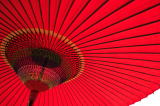 D.D.Revolution
D.D.Revolution